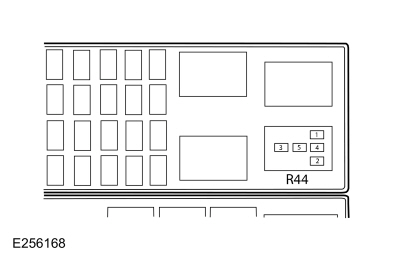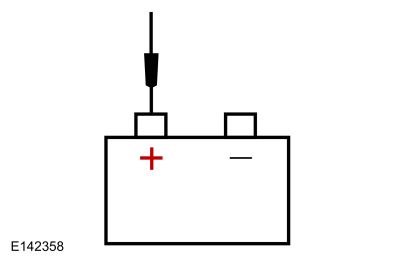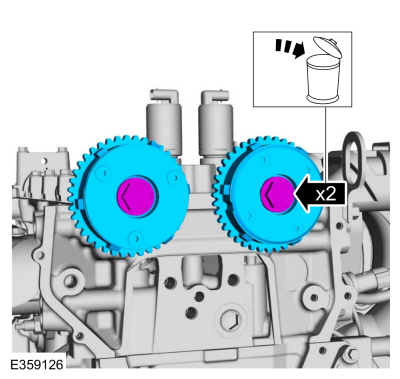Ford Ecosport: Wipers and Washers / Diagnosis and Testing - Wipers and Washers
Refer to Wiring Diagrams Cell 81 for schematic and connector information.
DTC Chart: BCM
Diagnostics in this manual assume a certain skill level and knowledge of Ford-specific diagnostic practices.
REFER to: Diagnostic Methods (100-00 General Information, Description and Operation).
| DTC | Description | Action |
| B130F:12 | Run Accessory Control: Circuit Short To Battery | GO to Pinpoint Test A |
| B130F:14 | Run Accessory Control: Circuit Short To Ground or Open |
|
| All other DTCs | - |
DTC Chart: SCCM
Diagnostics in this manual assume a certain skill level and knowledge of Ford-specific diagnostic practices.
REFER to: Diagnostic Methods (100-00 General Information, Description and Operation).
| DTC | Description | Action |
| B10AD:01 | Rain Sensor: General Electrical Failure | GO to Pinpoint Test F |
| B10AD:02 | Rain Sensor: General Signal Failure | GO to Pinpoint Test F |
| B10AD:08 | Rain Sensor: Bus Signal/Message Failure | GO to Pinpoint Test F |
| B10AD:49 | Rain Sensor: Internal Electronic Failure |
INSTALL a new rain sensor. REFER to: Rain Sensor (501-16 Wipers and Washers, Removal and Installation). |
| B10AD:55 | Rain Sensor: Not Configured | CARRY OUT the PMI for the SCCM using as built data. |
| B10AD:9A | Rain Sensor: Component or System Operating Conditions | DIAGNOSE the symptom present with the rain sensitive (Auto Wiper) feature. REFER to the Symptom Chart in this section. |
| B1131:01 | Wiper motor module: General Electrical Failure | GO to Pinpoint Test F |
| B1131:02 | Wiper motor module: General Signal Failure |
|
| B1131:08 | Wiper motor module: Bus Signal / Message Failure | GO to Pinpoint Test B |
| B1131:49 | Wiper motor module: Internal Electronic Failure |
|
| B1131:55 | Wiper motor module: Not Configured | CARRY OUT the PMI for the SCCM using as built data. |
| B1131:9A | Wiper motor module: Component or System Operating Conditions | DIAGNOSE the symptom present with the wiper/washer system. REFER to the Symptom Chart in this section. |
| B124E:11 | Wiper Stalk Switch Pack: Circuit Short To Ground |
|
| B124E:13 | Wiper Stalk Switch Pack: Circuit Open |
|
| B124E:55 | Wiper Stalk Switch Pack: Not Configured |
|
| B124E:96 | Wiper Stalk Switch Pack: Component Internal Failure |
|
| B124E:9E | Wiper Stalk Switch Pack: Stuck On |
|
| All other DTCs | - |
Symptom Chart
Symptom Chart: Wiper and Washer
Diagnostics in this manual assume a certain skill level and knowledge of Ford-specific diagnostic practices.
REFER to: Diagnostic Methods (100-00 General Information, Description and Operation).
Symptom Chart
| Condition | Actions |
|---|---|
| Wiper blade performance concerns - poor cleaning, streaking, or chatter |
|
| All windshield wiper modes are inoperative |
|
| The intermittent and/or low speed windshield wipers are inoperative |
|
| The high speed windshield wipers are inoperative |
|
| The windshield wipers stay on continuously |
|
| The windshield wipers do not operate correctly in the intermittent mode |
|
| The rain sensitive wiper (auto wiper) feature is inoperative |
|
| The rain sensitive wipers (auto wipers) have erratic/inconsistent operation |
|
| The rain sensitive wipers (auto wipers) are too sensitive/not sensitive enough to moisture |
|
| The windshield wipers do not park at the correct position |
|
| The windshield washer is inoperative |
|
| The windshield washer is always on |
|
| One or more rear window wiper modes are inoperative |
|
| The rear window wiper stays on continuously |
|
| The rear window washer is inoperative |
|
| The rear window washer is always on |
|
| The heated wiper park feature is inoperative |
|
| The heated wiper park feature is always on |
|
Pinpoint Tests
 PINPOINT TEST A: ALL WINDSHIELD WIPER MODES ARE INOPERATIVE
PINPOINT TEST A: ALL WINDSHIELD WIPER MODES ARE INOPERATIVE|
Refer to Wiring Diagrams Cell 81 for schematic and connector information. Normal Operation and Fault Conditions
REFER to: Wipers and Washers - System Operation and Component
Description (501-16 Wipers and Washers, Description and Operation). DTC Fault Trigger Conditions
Possible Sources
Visual Inspection and Pre-checks
NOTICE: Use the correct probe adapter(s) when making measurements. Failure to use the correct probe adapter(s) may damage the connector. |
|||||||||||||
| A1 CHECK FOR BCM (BODY CONTROL MODULE) DTC (DIAGNOSTIC TROUBLE CODE) B130F:12, B130F:14 OR SCCM (STEERING COLUMN CONTROL MODULE) DTC (DIAGNOSTIC TROUBLE CODE) B1131:02 | |||||||||||||
Is DTC B130F:12, B130F:14 or B1131:02 present?
|
|||||||||||||
| A2 CHECK THE WIPER RELAY CONTROL CIRCUIT FOR A SHORT TO VOLTAGE | |||||||||||||
Is any voltage present?
|
|||||||||||||
| A3 CHECK THE WIPER RELAY | |||||||||||||
Did the wiper relay pass the component test?
|
|||||||||||||
| A4 CHECK THE WIPER RELAY CONTROL CIRCUIT FOR A SHORT TO GROUND | |||||||||||||
Is the resistance less than 3 ohms?
|
|||||||||||||
| A5 CHECK THE WIPER RELAY CONTROL CIRCUIT FOR AN OPEN | |||||||||||||
Is the resistance less than 3 ohms?
|
|||||||||||||
| A6 CHECK THE INPUT TO THE SCCM (STEERING COLUMN CONTROL MODULE) USING THE WIPER/WASHER SWITCH PARAMETER IDENTIFICATIONS (PIDS) | |||||||||||||
Do the Parameter Identifications (PIDs) correspond correctly with each setting selection?
|
|||||||||||||
| A7 CHECK FOR VOLTAGE TO THE WINDSHIELD WIPER MOTOR | |||||||||||||
Is the voltage greater than 11 volts?
|
|||||||||||||
| A8 CHECK THE WIPER RELAY | |||||||||||||
Did the wiper relay pass the component test?
|
|||||||||||||
| A9 CHECK THE WINDSHIELD WIPER MOTOR VOLTAGE SUPPLY CIRCUIT FOR AN OPEN | |||||||||||||
Is the resistance less than 3 ohms?
|
|||||||||||||
| A10 CHECK THE WINDSHIELD WIPER RELAY VOLTAGE SUPPLY CIRCUITS FOR AN OPEN | |||||||||||||
Are both voltages greater than 11 volts?
|
|||||||||||||
| A11 CHECK THE WINDSHIELD WIPER MOTOR GROUND CIRCUIT FOR AN OPEN | |||||||||||||
Is the voltage greater than 11 volts?
|
|||||||||||||
| A12 CHECK THE FAIL-SAFE HIGH SPEED WIPER GROUND CIRCUIT CONTROL | |||||||||||||
|
NOTICE: The following Pinpoint Test uses a test lamp to simulate normal circuit loads. Use only a Rotunda Test Lamp (SGT27000) or 250-300mA incandescent bulb test lamp. To avoid connector terminal damage, use the Rotunda Flex Probe kit for the test lamp probe connection to the vehicle. Do not use the test lamp probe directly on any connector.
Does the test lamp illuminate when the wiper/washer switch is in the high speed setting?
|
|||||||||||||
| A13 CHECK THE FAIL-SAFE HIGH SPEED WIPER GROUND CIRCUIT FOR AN OPEN | |||||||||||||
|
NOTE: If steps A2-A11 did not identify the cause of the concern, a double fault is present. After the fail-safe ground is diagnosed and repaired, it is necessary check all operation modes and diagnose any symptom still present.
Is the resistance less than 3 ohms?
|
|||||||||||||
| A14 CHECK FOR CORRECT WINDSHIELD WIPER MOTOR OPERATION | |||||||||||||
Is the concern still present?
|
|||||||||||||
| A15 CHECK FOR CORRECT SCCM (STEERING COLUMN CONTROL MODULE) OPERATION | |||||||||||||
Is the concern still present?
|
|||||||||||||
| A16 CHECK FOR CORRECT BCM (BODY CONTROL MODULE) OPERATION | |||||||||||||
Is the concern still present?
|
 PINPOINT TEST B: THE INTERMITTENT AND/OR LOW SPEED WINDSHIELD WIPERS ARE INOPERATIVE
PINPOINT TEST B: THE INTERMITTENT AND/OR LOW SPEED WINDSHIELD WIPERS ARE INOPERATIVE|
Refer to Wiring Diagrams Cell 81 for schematic and connector information. Normal Operation and Fault Conditions
REFER to: Wipers and Washers - System Operation and Component
Description (501-16 Wipers and Washers, Description and Operation). DTC Fault Trigger Conditions
Possible Sources
Visual Inspection and Pre-checks
NOTE: It may be necessary to disconnect and then reconnect the battery after the repair to enable the wiper operation. |
||||||||||
| B1 CHECK THE HIGH SPEED WIPER OPERATION | ||||||||||
Do the windshield wipers operate with the wiper/washer switch in the high speed setting?
|
||||||||||
| B2 CHECK THE LOW SPEED WIPER OPERATION | ||||||||||
Do the windshield wipers operate with the wiper/washer switch in the low speed setting?
|
||||||||||
| B3 CHECK THE INPUT TO THE SCCM (STEERING COLUMN CONTROL MODULE) | ||||||||||
Does the PID indicate the wiper/washer switch is in the low speed setting?
|
||||||||||
| B4 ISOLATE THE RAIN SENSOR | ||||||||||
Do the windshield wipers operate with the wiper/washer switch in the low speed setting?
|
||||||||||
| B5 CHECK THE LIN (LOCAL INTERCONNECT NETWORK) CIRCUIT FOR A SHORT TO VOLTAGE | ||||||||||
Is any voltage present?
|
||||||||||
| B6 CHECK THE LIN (LOCAL INTERCONNECT NETWORK) CIRCUIT FOR A SHORT TO GROUND | ||||||||||
Is the resistance greater than 10,000 ohms?
|
||||||||||
| B7 CHECK THE LIN (LOCAL INTERCONNECT NETWORK) CIRCUIT FOR AN OPEN | ||||||||||
Is the resistance less than 3 ohms?
|
||||||||||
| B8 CHECK FOR CORRECT WINDSHIELD WIPER MOTOR OPERATION | ||||||||||
Is the concern still present?
|
||||||||||
| B9 CHECK FOR CORRECT SCCM (STEERING COLUMN CONTROL MODULE) OPERATION | ||||||||||
Is the concern still present?
|
 PINPOINT TEST C: THE HIGH SPEED WINDSHIELD WIPERS ARE INOPERATIVE
PINPOINT TEST C: THE HIGH SPEED WINDSHIELD WIPERS ARE INOPERATIVE|
Normal Operation and Fault Conditions
REFER to: Wipers and Washers - System Operation and Component
Description (501-16 Wipers and Washers, Description and Operation). Possible Sources
|
||||
| C1 CHECK THE INPUT TO THE SCCM (STEERING COLUMN CONTROL MODULE) | ||||
Does the PID indicate the wiper/washer switch is in the high speed setting?
|
 PINPOINT TEST D: THE WINDSHIELD WIPERS STAY ON CONTINUOUSLY
PINPOINT TEST D: THE WINDSHIELD WIPERS STAY ON CONTINUOUSLY|
Refer to Wiring Diagrams Cell 81 for schematic and connector information. Normal Operation and Fault Conditions
REFER to: Wipers and Washers - System Operation and Component
Description (501-16 Wipers and Washers, Description and Operation). DTC Fault Trigger Conditions
Possible Sources
Visual Inspection and Pre-checks
|
||||||||||
| D1 CHECK THE WINDSHIELD WIPER OPERATION WITH THE IGNITION OFF | ||||||||||
Do the windshield wipers operate with the ignition off?
|
||||||||||
| D2 CHECK THE WINDSHIELD WIPER OPERATION WITH THE SCCM (STEERING COLUMN CONTROL MODULE) DISCONNECTED | ||||||||||
Do the windshield wipers continue to operate?
|
||||||||||
| D3 CHECK THE HIGH SPEED FAIL-SAFE CIRCUIT FOR A SHORT TO GROUND | ||||||||||
Is the resistance greater than 10,000 ohms?
|
||||||||||
| D4 CHECK FOR CORRECT WINDSHIELD WIPER MOTOR OPERATION | ||||||||||
Is the concern still present?
|
||||||||||
| D5 CHECK FOR BCM (BODY CONTROL MODULE) DTC (DIAGNOSTIC TROUBLE CODE) B130F:14 | ||||||||||
Is DTC B130F:14 present?
|
||||||||||
| D6 CHECK THE WIPER RELAY CONTROL CIRCUIT FOR A SHORT TO GROUND | ||||||||||
Is the resistance greater than 10,000 ohms?
|
||||||||||
| D7 CHECK THE WINDSHIELD WIPER SYSTEM VOLTAGE SUPPLY CIRCUITS FOR A SHORT TO VOLTAGE | ||||||||||
Does the windshield wiper motor continue to operate?
|
||||||||||
| D8 CHECK FOR CORRECT SCCM (STEERING COLUMN CONTROL MODULE) OPERATION | ||||||||||
Is the concern still present?
|
||||||||||
| D9 CHECK FOR CORRECT BCM (BODY CONTROL MODULE) OPERATION | ||||||||||
Is the concern still present?
|
 PINPOINT TEST E: THE WINDSHIELD WIPERS DO NOT OPERATE CORRECTLY IN THE INTERMITTENT MODE
PINPOINT TEST E: THE WINDSHIELD WIPERS DO NOT OPERATE CORRECTLY IN THE INTERMITTENT MODE|
Normal Operation and Fault Conditions
REFER to: Wipers and Washers - System Operation and Component
Description (501-16 Wipers and Washers, Description and Operation). Possible Sources
Visual Inspection and Pre-checks
|
||||
| E1 VERIFY IF THE VEHICLE IS EQUIPPED WITH A RAIN SENSOR | ||||
Is the vehicle equipped with a rain sensor?
|
||||
| E2 VERIFY THE RAIN SENSITIVE WIPER (AUTO WIPER) FEATURE IS DISABLED IN THE VEHICLE MESSAGE CENTER | ||||
Is the rain sensitive feature enabled?
|
||||
| E3 CHECK THE LOW SPEED WIPER OPERATION | ||||
Do the low speed wipers operate when the low speed setting is selected?
|
||||
| E4 CHECK THE INPUT FROM THE WIPER/ WASHER SWITCH | ||||
Do the PIDs correspond correctly with each setting selection?
|
 PINPOINT TEST F: THE RAIN SENSITIVE WIPER FEATURE IS INOPERATIVE/DOES NOT OPERATE CORRECTLY
PINPOINT TEST F: THE RAIN SENSITIVE WIPER FEATURE IS INOPERATIVE/DOES NOT OPERATE CORRECTLY|
Refer to Wiring Diagrams Cell 81 for schematic and connector information. Normal Operation and Fault Conditions
REFER to: Wipers and Washers - System Operation and Component
Description (501-16 Wipers and Washers, Description and Operation). DTC Fault Trigger Conditions
Possible Sources
Visual Inspection and Pre-checks
|
||||||||||||
| F1 CHECK THE LOW SPEED WIPER OPERATION | ||||||||||||
Do the low speed wipers operate when the low speed setting is selected?
|
||||||||||||
| F2 CHECK FOR DTC (DIAGNOSTIC TROUBLE CODE) B10AD:01, B10AD:02 OR B10AD:08 | ||||||||||||
Are any Diagnostic Trouble Codes (DTCs) present?
|
||||||||||||
| F3 VERIFY THE RAIN SENSITIVE WIPER FEATURE IS ENABLED IN THE VEHICLE MESSAGE CENTER | ||||||||||||
Is the rain sensitive feature enabled?
|
||||||||||||
| F4 CHECK THE INPUT FROM THE WIPER/WASHER SWITCH | ||||||||||||
Do the Parameter Identifications (PIDs) correspond correctly with each setting selection?
|
||||||||||||
| F5 CHECK THE WINDSHIELD FOR DAMAGE | ||||||||||||
Is any windshield damage present near the area of the rain sensor?
|
||||||||||||
| F6 CHECK THE WINDSHIELD GLASS FOR STREAKING | ||||||||||||
Is any streaking present on the windshield around the area of the rain sensor?
|
||||||||||||
| F7 CHECK THE WINDSHIELD WIPER BLADES FOR STREAKING | ||||||||||||
Was there noticeable improvement in the wipe quality after cleaning the glass and the wiper blades?
|
||||||||||||
| F8 RECHECK THE RAIN SENSITIVE WIPERS OPERATION | ||||||||||||
Do the wipers operate when water is applied to the windshield surface?
|
||||||||||||
| F9 CHECK FOR THE PRESENCE OF THE LENS GEL | ||||||||||||
Does the rain sensor remain adhered to the windshield?
|
||||||||||||
| F10 INSPECT THE RAIN SENSOR MOUNTING AREA | ||||||||||||
|
NOTE: The rain sensor gel-type lens can be damaged or contaminated during rain sensor removal, rain sensor bracket separation or incorrect installation.
Does the rain sensor contact area appear black, with no bubbles, air pockets or contaminants between the windshield glass and the rain sensor?
|
||||||||||||
| F11 CHECK FOR VOLTAGE TO THE RAIN SENSOR | ||||||||||||
Is the voltage greater than 11 volts?
|
||||||||||||
| F12 CHECK THE RAIN SENSOR GROUND CIRCUIT FOR AN OPEN | ||||||||||||
Is the voltage above 11 volts?
|
||||||||||||
| F13 CHECK THE LIN (LOCAL INTERCONNECT NETWORK) CIRCUIT FOR AN OPEN | ||||||||||||
Is the resistance less than 3 ohms?
|
||||||||||||
| F14 CHECK FOR CORRECT SCCM (STEERING COLUMN CONTROL MODULE) OPERATION | ||||||||||||
Is the concern still present?
|
 PINPOINT TEST G: THE WINDSHIELD WIPERS DO NOT PARK AT THE CORRECT POSITION
PINPOINT TEST G: THE WINDSHIELD WIPERS DO NOT PARK AT THE CORRECT POSITION|
Normal Operation and Fault Conditions
REFER to: Wipers and Washers - System Operation and Component
Description (501-16 Wipers and Washers, Description and Operation). Possible Sources
Visual Inspection and Pre-checks
|
||||
| G1 CHECK THE WIPER PIVOT ARM AND SHAFT FOR DAMAGE | ||||
Is the wiper pivot arm and shaft OK?
|
||||
| G2 CHECK THE WINDSHIELD WIPER PARK RELAY OPERATION | ||||
Do the windshield wipers immediately stop when the wiper/washer switch is turned off?
|
 PINPOINT TEST H: THE WINDSHIELD WASHER IS INOPERATIVE
PINPOINT TEST H: THE WINDSHIELD WASHER IS INOPERATIVE|
Refer to Wiring Diagrams Cell 81 for schematic and connector information. Normal Operation and Fault Conditions
REFER to: Wipers and Washers - System Operation and Component
Description (501-16 Wipers and Washers, Description and Operation). Possible Sources
Visual Inspection and Pre-checks
NOTICE: Use the correct probe adapter(s) when making measurements. Failure to use the correct probe adapter(s) may damage the connector. |
||||||||||
| H1 CHECK FOR WASHER PUMP ACTIVATION | ||||||||||
Does the washer pump activate?
|
||||||||||
| H2 CHECK THE AMBIENT AIR TEMPERATURE | ||||||||||
Is the ambient air temperature below freezing?
|
||||||||||
| H3 CHECK THE WASHER SOLVENT | ||||||||||
Is the correct type of washer solvent present?
|
||||||||||
| H4 CHECK FOR WASHER SOLVENT TO THE WASHER JETS | ||||||||||
Is washer fluid emitted at the washer hoses?
|
||||||||||
| H5 CHECK FOR DAMAGED WASHER HOSES AND FITTINGS | ||||||||||
Are the washer hoses and fittings OK?
|
||||||||||
| H6 CHECK THE WIPER/WASHER SWITCH INPUT USING THE WASHER SWITCH (FRONT) (F_WASH_SW) PID (PARAMETER IDENTIFICATION) | ||||||||||
Does the PID indicate correctly when the switch is activated?
|
||||||||||
| H7 CHECK FOR VOLTAGE TO THE WASHER PUMP | ||||||||||
|
NOTICE: This pinpoint test step uses a test lamp to simulate normal circuit loads. Use only a Rotunda Test Lamp (SGT27000) or 250-300mA incandescent bulb test lamp. To avoid connector terminal damage, use the Rotunda Flex Probe kit for the test lamp probe connection to the vehicle. Do not use the test lamp probe directly on any connector.
Does the test lamp illuminate when the washer is activated?
|
||||||||||
| H8 CHECK THE WASHER PUMP GROUND CIRCUIT FOR AN OPEN | ||||||||||
|
NOTICE: This pinpoint test step uses a test lamp to simulate normal circuit loads. Use only a Rotunda Test Lamp (SGT27000) or 250-300mA incandescent bulb test lamp. To avoid connector terminal damage, use the Rotunda Flex Probe kit for the test lamp probe connection to the vehicle. Do not use the test lamp probe directly on any connector.
Does the test lamp illuminate when the washer is activated?
|
||||||||||
| H9 CHECK THE WASHER PUMP RELAY GROUND CIRCUIT FOR AN OPEN | ||||||||||
Is the resistance less than 3 ohms?
|
||||||||||
| H10 CHECK THE WASHER PUMP VOLTAGE SUPPLY CIRCUIT FOR A SHORT TO GROUND | ||||||||||
Is the resistance greater than 10,000 ohms?
|
||||||||||
| H11 CHECK THE WASHER PUMP VOLTAGE SUPPLY CIRCUIT FOR AN OPEN | ||||||||||
Is the resistance less than 3 ohms?
|
||||||||||
| H12 CHECK FOR CORRECT WINDSHIELD WIPER MOTOR OPERATION | ||||||||||
Is the concern still present?
|
 PINPOINT TEST I: THE WINDSHIELD WASHER IS ALWAYS ON
PINPOINT TEST I: THE WINDSHIELD WASHER IS ALWAYS ON|
Refer to Wiring Diagrams Cell 81 for schematic and connector information. Normal Operation and Fault Conditions
REFER to: Wipers and Washers - System Operation and Component
Description (501-16 Wipers and Washers, Description and Operation). Possible Sources
Visual Inspection and Pre-checks
|
||||
| I1 CHECK THE WIPER/WASHER SWITCH INPUT USING THE WASHER SWITCH (FRONT) (F_WASH_SW) PID | ||||
Does the PID indicate the switch is activated?
|
 PINPOINT TEST J: ONE OR MORE REAR WINDOW WIPER MODES ARE INOPERATIVE
PINPOINT TEST J: ONE OR MORE REAR WINDOW WIPER MODES ARE INOPERATIVE|
Refer to Wiring Diagrams Cell 81 for schematic and connector information. Normal Operation and Fault Conditions
REFER to: Wipers and Washers - System Operation and Component
Description (501-16 Wipers and Washers, Description and Operation). Possible Sources
Visual Inspection and Pre-checks
NOTICE: Use the correct probe adapter(s) when making measurements. Failure to use the correct probe adapter(s) may damage the connector. |
||||||||||
| J1 CHECK THE WINDSHIELD WIPER OPERATION | ||||||||||
Does the windshield wiper operate?
|
||||||||||
| J2 CHECK THE REAR WINDOW WIPER/WASHER SWITCH INPUT PARAMETER IDENTIFICATIONS (PIDS) | ||||||||||
Do the Parameter Identifications (PIDs) indicate correctly for the switch positions?
|
||||||||||
| J3 CHECK FOR VOLTAGE TO THE REAR WINDOW WIPER MOTOR | ||||||||||
Is the voltage greater than 11 volts?
|
||||||||||
| J4 CHECK THE REAR WINDOW WIPER MOTOR VOLTAGE SUPPLY CIRCUIT FOR AN OPEN | ||||||||||
Is the resistance less than 3 ohms?
|
||||||||||
| J5 CHECK THE REAR WINDOW WIPER MOTOR GROUND CIRCUIT FOR AN OPEN | ||||||||||
Is the voltage greater than 11 volts?
|
||||||||||
| J6 CHECK THE REAR WINDOW WIPER MOTOR CONTROL CIRCUIT FOR A SHORT TO VOLTAGE | ||||||||||
Is any voltage present?
|
||||||||||
| J7 CHECK THE REAR WINDOW WIPER MOTOR CONTROL CIRCUIT FOR AN OPEN | ||||||||||
Is the resistance less than 3 ohms?
|
||||||||||
| J8 BYPASS THE WINDSHIELD WIPER MOTOR | ||||||||||
Does the rear window wiper motor operate?
|
||||||||||
| J9 CHECK FOR CORRECT WINDSHIELD WIPER MOTOR OPERATION | ||||||||||
Is the concern still present?
|
 PINPOINT TEST K: THE REAR WINDOW WIPER STAYS ON CONTINUOUSLY
PINPOINT TEST K: THE REAR WINDOW WIPER STAYS ON CONTINUOUSLY|
Refer to Wiring Diagrams Cell 81 for schematic and connector information. Normal Operation and Fault Conditions
REFER to: Wipers and Washers - System Operation and Component
Description (501-16 Wipers and Washers, Description and Operation). Possible Sources
Visual Inspection and Pre-checks
NOTICE: Use the correct probe adapter(s) when making measurements. Failure to use the correct probe adapter(s) may damage the connector. |
||||||||||
| K1 CHECK THE REAR WINDOW WIPER/WASHER SWITCH INPUT PARAMETER IDENTIFICATIONS (PIDS) | ||||||||||
Do the Parameter Identifications (PIDs) indicate correctly for the switch positions?
|
||||||||||
| K2 CHECK THE WINDSHIELD WIPER MOTOR | ||||||||||
Does the rear window wiper motor continue to operate?
|
||||||||||
| K3 CHECK THE WINDSHIELD REAR WIPER CONTROL CIRCUIT FOR A SHORT TO GROUND | ||||||||||
Is the resistance greater than 10,000 ohms?
|
||||||||||
| K4 CHECK FOR CORRECT WINDSHIELD WIPER MOTOR OPERATION | ||||||||||
Is the concern still present?
|
 PINPOINT TEST L: THE REAR WINDOW WASHER IS INOPERATIVE
PINPOINT TEST L: THE REAR WINDOW WASHER IS INOPERATIVE|
Refer to Wiring Diagrams Cell 81 for schematic and connector information. Normal Operation and Fault Conditions
REFER to: Wipers and Washers - System Operation and Component
Description (501-16 Wipers and Washers, Description and Operation). Possible Sources
Visual Inspection and Pre-checks
NOTICE: Use the correct probe adapter(s) when making measurements. Failure to use the correct probe adapter(s) may damage the connector. |
||||||||||
| L1 CHECK THE WINDSHIELD WASHER OPERATION | ||||||||||
Does windshield washer operate correctly?
|
||||||||||
| L2 CHECK THE AMBIENT AIR TEMPERATURE | ||||||||||
Is the ambient air temperature below freezing?
|
||||||||||
| L3 CHECK THE WASHER SOLVENT | ||||||||||
Is the correct type of washer solvent present?
|
||||||||||
| L4 CHECK FOR WASHER SOLVENT TO THE WASHER JET | ||||||||||
Is washer fluid emitted at the washer hose?
|
||||||||||
| L5 CHECK FOR DAMAGED WASHER HOSES AND FITTINGS | ||||||||||
Are the washer hoses and fittings OK?
|
||||||||||
| L6 CHECK THE WIPER/WASHER SWITCH INPUT USING THE REAR WIPER WASH SWITCH (R_WIPE_WASH_SW) PID (PARAMETER IDENTIFICATION) | ||||||||||
Does the PID indicate correctly when the switch is activated and released?
|
||||||||||
| L7 CHECK THE REAR WASHER RELAY COIL CIRCUIT | ||||||||||
|
NOTICE: The following Pinpoint Test uses a test lamp to simulate normal circuit loads. Use only a Rotunda Test Lamp (SGT27000) or 250-300mA incandescent bulb test lamp. To avoid connector terminal damage, use the Rotunda Flex Probe kit for the test lamp probe connection to the vehicle. Do not use the test lamp probe directly on any connector.
Does the test lamp illuminate when the rear window wash function is activated?
|
||||||||||
| L8 CHECK THE WASHER PUMP GROUND CIRCUIT | ||||||||||
|
NOTICE: The following Pinpoint Test uses a test lamp to simulate normal circuit loads. Use only a Rotunda Test Lamp (SGT27000) or 250-300mA incandescent bulb test lamp. To avoid connector terminal damage, use the Rotunda Flex Probe kit for the test lamp probe connection to the vehicle. Do not use the test lamp probe directly on any connector.
Does the test lamp illuminate?
|
||||||||||
| L9 CHECK THE REAR WASHER RELAY COIL CONTROL CIRCUIT FOR AN OPEN | ||||||||||
Is the resistance less than 3 ohms?
|
||||||||||
| L10 CHECK THE REAR WASHER RELAY | ||||||||||
Did the rear washer relay pass the component test?
|
||||||||||
| L11 CHECK THE REAR WASHER RELAY COIL CONTROL CIRCUIT FOR A SHORT TO VOLTAGE | ||||||||||
Is any voltage present?
|
||||||||||
| L12 CHECK THE REAR WASHER RELAY COIL CONTROL CIRCUIT FOR AN OPEN | ||||||||||
Is the resistance less than 3 ohms?
|
||||||||||
| L13 CHECK FOR CORRECT WINDSHIELD WIPER MOTOR OPERATION | ||||||||||
Is the concern still present?
|
 PINPOINT TEST M: THE REAR WINDOW WASHER IS ALWAYS ON
PINPOINT TEST M: THE REAR WINDOW WASHER IS ALWAYS ON|
Refer to Wiring Diagrams Cell 81 for schematic and connector information. Normal Operation and Fault Conditions
REFER to: Wipers and Washers - System Operation and Component
Description (501-16 Wipers and Washers, Description and Operation). Possible Sources
Visual Inspection and Pre-checks
|
||||||||||
| M1 CHECK THE WIPER/WASHER SWITCH INPUT USING THE REAR WIPER WASH SWITCH (R_WIPE_WASH_SW) PID (PARAMETER IDENTIFICATION) | ||||||||||
Does the PID indicate correctly when the switch is activated and released?
|
||||||||||
| M2 CHECK THE REAR WASHER RELAY COIL CONTROL CIRCUIT FOR A SHORT TO GROUND | ||||||||||
Is the resistance greater than 10,000 ohms?
|
||||||||||
| M3 ISOLATE THE REAR WASHER RELAY COIL CONTROL CIRCUIT SHORT TO GROUND | ||||||||||
Is the resistance greater than 10,000 ohms?
|
||||||||||
| M4 CHECK THE REAR WASHER RELAY OUTPUT CIRCUIT FOR A SHORT TO VOLTAGE | ||||||||||
Is any voltage present?
|
||||||||||
| M5 CHECK THE REAR WASHER RELAY OUTPUT CIRCUIT FOR A SHORT TO VOLTAGE IN THE BJB | ||||||||||
Is any voltage present?
|
||||||||||
| M6 CHECK FOR CORRECT WINDSHIELD WIPER MOTOR OPERATION | ||||||||||
Is the concern still present?
|
 PINPOINT TEST N: THE HEATED WIPER PARK FEATURE IS INOPERATIVE
PINPOINT TEST N: THE HEATED WIPER PARK FEATURE IS INOPERATIVE|
Refer to Wiring Diagrams Cell 81 for schematic and connector information. Normal Operation and Fault Conditions
REFER to: Wipers and Washers - System Operation and Component
Description (501-16 Wipers and Washers, Description and Operation). Possible Sources
Visual Inspection and Pre-checks
NOTICE: Use the correct probe adapter(s) when making measurements. Failure to use the correct probe adapter(s) may damage the connector. NOTICE: The following Pinpoint Test uses a test lamp to simulate normal circuit loads. Use only a Rotunda Test Lamp (SGT27000) or 250-300mA incandescent bulb test lamp. To avoid connector terminal damage, use the Rotunda Flex Probe kit for the test lamp probe connection to the vehicle. Do not use the test lamp probe directly on any connector. NOTE: The heated wiper park does not operate at ambient temperatures above 21° C (70° F). The following pinpoint test needs to be carried out when the ambient air temperature is lower than 21° C (70° F). |
|||||||||||||
| N1 CHECK THE REAR WINDOW DEFROST OPERATION | |||||||||||||
Does the rear window defrost operate?
|
|||||||||||||
| N2 CHECK THE HEATED WIPER PARK RELAY | |||||||||||||
Did the heated wiper park relay pass the component test?
|
|||||||||||||
| N3 CHECK FOR VOLTAGE TO THE HEATED WINDSHIELD | |||||||||||||
Does the test lamp illuminate when the rear window defrost feature is activated?
|
|||||||||||||
| N4 CHECK THE HEATED WIPER PARK RELAY OUTPUT CIRCUIT FOR AN OPEN | |||||||||||||
Is the resistance less than 3 ohms?
|
|||||||||||||
| N5 CHECK THE HEATED WIPER PARK RELAY VOLTAGE SUPPLY CIRCUITS FOR AN OPEN | |||||||||||||
Are both voltages greater than 11 volts?
|
|||||||||||||
| N6 CHECK THE HEATED WIPER PARK RELAY COIL CONTROL CIRCUIT FOR AN OPEN | |||||||||||||
Does the test lamp illuminate when the rear window defrost is activated?
|
|||||||||||||
| N7 CHECK THE WINDSHIELD HEATED WIPER PARK GROUND CIRCUIT FOR AN OPEN | |||||||||||||
Does the test lamp illuminate when the rear window defrost feature is activated?
|
 PINPOINT TEST O: THE HEATED WIPER PARK FEATURE IS ALWAYS ON
PINPOINT TEST O: THE HEATED WIPER PARK FEATURE IS ALWAYS ON|
Refer to Wiring Diagrams Cell 81 for schematic and connector information. Normal Operation and Fault Conditions
REFER to: Wipers and Washers - System Operation and Component
Description (501-16 Wipers and Washers, Description and Operation). Possible Sources
NOTICE: Use the correct probe adapter(s) when making measurements. Failure to use the correct probe adapter(s) may damage the connector. |
||||||||||
| O1 CHECK THE REAR WINDOW DEFROST OPERATION | ||||||||||
Is the rear window defrost active?
|
||||||||||
| O2 CHECK THE HEATED WIPER PARK RELAY OUTPUT CIRCUIT FOR A SHORT TO VOLTAGE | ||||||||||
Does the test light illuminate?
|
 PINPOINT TEST P: WIPER BLADE PERFORMANCE CONCERNS - POOR CLEANING, STREAKING, OR CHATTER
PINPOINT TEST P: WIPER BLADE PERFORMANCE CONCERNS - POOR CLEANING, STREAKING, OR CHATTER|
Normal Operation and Fault Conditions Wiper blade cleaning, streaking, or chatter concerns are commonly caused by dirt, ice, debris, or other foreign material on the wiper blade(s) or glass surface. The wiper blades and glass surface should be cleaned and retested prior to replacing wiper blades for a cleaning, streaking, or chatter concern. Possible Sources
Visual Inspection and Pre-checks
|
||||
| P1 CLEAN THE WIPER BLADES AND GLASS SURFACE | ||||
Is the wiper performance concern still present (poor cleaning, streaking, chatter)?
|
 Removal and Installation - Rain Sensor
Removal and Installation - Rain Sensor
Removal
NOTE:
Removal steps in this procedure may contain installation details.
Remove the rearward trim cover.
Remove the forward trim cover...
Other information:
Ford Ecosport 2014-2025 Service and Repair Manual: Removal and Installation - Rear Door Speaker
Removal NOTE: Removal steps in this procedure may contain installation details. Remove the rear door trim panel. Refer to: Rear Door Trim Panel (501-05 Interior Trim and Ornamentation, Removal and Installation). Disconnect the electrical connector, remove the screws and the rear door speaker...
Ford Ecosport 2014-2025 Service and Repair Manual: Description and Operation - Communications Network - System Operation and Component Description
System Operation System Operation *.sttxt { visibility: hidden; } *.stcallout { visibility: visible; } E356703 ..

 PINPOINT TEST A: ALL WINDSHIELD WIPER MODES ARE INOPERATIVE
PINPOINT TEST A: ALL WINDSHIELD WIPER MODES ARE INOPERATIVE

 Wiper relay, cavity 2
Wiper relay, cavity 2


 Heated wiper park relay, cavity 2
Heated wiper park relay, cavity 2
 Battery Positive
Battery Positive

